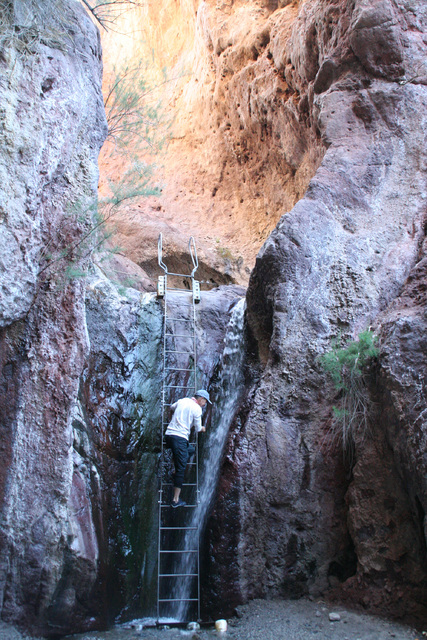Day Trips: Cool time of year to enjoy Arizona Hot Springs
With weather cooling off, it is the ideal time of year to hit the trail and also to enjoy a soak in one of our regional hot springs. To combine both these pleasures in a single outing, one of our area’s best destinations is Arizona Hot Springs in Lake Mead National Recreation Area.
The hike to the springs is about 6.4 miles roundtrip from trailhead to the Colorado River and back. Elevation change is an 875-foot loss on the first half and, of course, 875 feet gain on the uphill return. This will be a moderate hike for most people. The trailhead is easy to find, about four miles south of the Hoover Dam Bypass Bridge.
From the trailhead and parking area drop down into White Rock Canyon and head downstream, under the highway. The wide, rocky wash soon narrows, and the walking becomes easier on soft gravel between high walls of volcanic rock. Keep a lookout for desert bighorn sheep, as they frequent this area.
After about 2.6 miles you will arrive on the banks of the Colorado River in Black Canyon. Pick up the worn path that heads downstream, and head up the steep hill of volcanic rock. There are signs to show you the way. This section is a little hard to negotiate as it is through the rocky cliffs themselves but soon the path brings you down into a vegetated, narrow canyon with a small ribbon of water flowing through it.
Put on your water shoes here if you have them (do not wear flip flops as they will not stay on your feet). Head to your left, upstream, walking in the streambed itself. In just a couple of minutes the canyon will widen enough to contain a small, dry gravel bar at the base of a waterfall. Here you will find a sturdy metal ladder, perhaps 20 feet tall, which will give you access to the hanging canyon with the hot springs at its mouth.
Once up on top, you will find pools of water to soak in. These tend to vary in size and configuration anytime you visit, because they are dammed by sandbags, which energetic people sometimes rearrange to suit themselves. The water here flows at a rate of about 30 gallons per minute, with the water being warmer at the upstream end.
Heated by molten rock, the water reaches the surface of the earth through faults. The water is highly mineralized with chloride, sulfates, potassium and other natural chemicals. Like other hot springs in our region, this one may contain an amoeba called Nargleria Fowleria. It is extremely rare that a human is infected thereby, but it can be fatal. You can safely soak in the springs, though, if you never submerge your head and never allow water to get into your nose, mouth, or eyes.
For a hike-and-soak, Mondays and Tuesdays are best. On these days this section of the river, between Hoover Dam and Willow Beach, is closed to motorized vessels and personal watercraft, which reduces the number of visitors. Even so, some will arrive by kayak, canoe, raft or standup paddleboard. Because this is such a popular destination, start on the trail at daybreak for your best chance to enjoy it in solitude.
One more caveat: As is true in all narrow canyons with few exits, flash floods could be deadly here and on the access trail. If rain is falling, threatening, or even predicted, save this hike for some clear day.
Directions:
From Pahrump take NV-160 south about 52 miles to Las Vegas.
Merge onto I-215 east and drive about 12 miles.
Merge right onto U.S. 93 south and drive about 19 miles passing through Boulder City and into Arizona via the Hoover Dam bypass bridge.
Continue about 2.6 miles and go left at signed White Rock Canyon crossover and to the paved parking area.
Deborah Wall is the author of “Base Camp Las Vegas, Hiking the Southwestern States,” “Great Hikes, A Cerca Country Guide,” and co-author of “Access For All, Touring the Southwest with Limited Mobility.” Wall can be reached at Deborabus@aol.com.
















